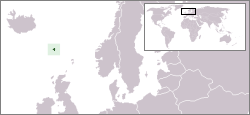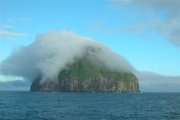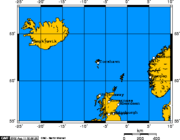Faroe Islands
|
|
| |||||

| |||||
| Official language | Faroese | ||||
|---|---|---|---|---|---|
| Capital | Tórshavn | ||||
| Monarch | Margrethe II | ||||
| Prime Minister | Jóannes Eidesgaard | ||||
| Area - Total - % water | World ranking: 189th 1,399 km² 0.5 | ||||
| Population - Total (2004) - Density | World ranking: 211th 48,228 33.1/km² | ||||
| Independence | None1 | ||||
| Currency | Faroese króna2 | ||||
| Time zone | WET (UTC; UTC+1 in summer) | ||||
| National anthem | Tú alfagra land mítt (My land, oh most beauteous) | ||||
| Internet TLD | .fo | ||||
| Calling Code | 298 | ||||
| Electricity | 230V, 50 Hz | ||||
| 1Danish dependency. Self governing since 1948. 2Same value as Danish krone | |||||
The Faroe Islands or simply Faroes (Faroese: Føroyar, meaning "Sheep Islands") are a group of islands in the north Atlantic Ocean between Scotland, Norway and Iceland. They have been an autonomous region of the kingdom of Denmark since 1948 and have over the years taken control over and responsibility of most matters except defence and foreign affairs.
The Faroes give their name to one of the British Sea Areas. There are traditional close ties to Iceland and the neighbours of Shetland, the Orkney Islands and Western Isles. Another special relation exists to Greenland, while the Faroes are part of the framework within the Nordic Council.
| Contents |
History
Main article: History of the Faroe Islands
The early history of the Faroe Islands is very clear. According to Færeyinga Saga emigrants who left Norway to escape the tyranny of Harald I of Norway, settled in the islands about the beginning of the 9th century. Early in the 11th century Sigmund or Sigmundur Brestirson, whose family had flourished in the southern islands but had been almost exterminated by invaders from the northern, was sent from Norway, whence he had escaped, to take possession of the islands for Olaf Tryggvason, king of Norway. He introduced Christianity and, though he was subsequently murdered, Norwegian supremacy was upheld and continued until 1386, when the islands became part of the Kalmar Union and later the double monarchy Denmark–Norway. The reformation reached the Faroes in 1568. Denmark retained possession of the Faroe Islands at the Treaty of Kiel in 1814.
The monopoly trade over the Faroe Islands was abolished 1856. Since then, the country developed towards a modern fishery nation with an own fleet. The national awakening since 1888 was first struggling for the Faroese language, thus more cultural orientated, but after 1906 more and more politically after the foundation of the political Parties of the Faroe Islands.
On April 12, 1940, the Faroes were occupied by British troops following the invasion of Denmark by Nazi Germany. This action was taken to avert a possible German occupation of the islands, which would have had very grave consequences for the course of the Battle of the Atlantic. In 1942–43 the British Royal Engineers built the only airport in the Faroes, the Vagar Airport. Control of the islands reverted to Denmark following the war, but in 1948 a home rule regime was implemented granting a high degree of local autonomy. The Faroes declined to join Denmark in entering the European Community (now European Union) in 1973. The islands experienced considerable economic difficulties following the collapse of the fishing industry in the early 1990's, but have made efforts to diversify the economy since then. Support for independence has grown and is the objective of the government.
Politics
Main article: Politics of the Faroe Islands
The islands are administratively parted in 34 municipalities with about 120 cities and villages.
Traditionally, there are also the 6 sýslur (Norðoyar, Eysturoy, Streymoy, Vágar, Sandoy and Suðuroy). Sýsla means district and is only a police district today, but commonly also understood as a geographical region. In earlier times, each sýsla had an own ting, the so called várting (spring ting).
Today, elections are held in the municipalities, on national level for the Løgting, and inside the Kingdom of Denmark for the Folketing. For the Løgting elections are there 7 election districts, which are the sýslur, while Streymoy is divided in a northern and southern part (Tórshavn region).
The Faroes and Denmark
A high degree of self-government was attained in 1948 and the Faroese are supported by a substantial annual subsidy from Denmark. The islanders are about evenly split between those favoring complete independence and those who prefer continued presence in the Danish state. Within both camps there is, however, a wide range of opinion. Of those who favor independence some are in favor of an immediate unilateral declaration. Others see it as something to be attained gradually and in full consent with the Danish government and the Danish nation. In the unionist camp there are also many who foresee and welcome a gradual increase in autonomy even as strong ties to Denmark are maintained.
The Faroes and the EU
The Faroe Islands are not part of the EU, as explicitly asserted by both Rome treaties. Moreover, a protocol to the treaty of accession of Denmark to the European Communities stipulates that Danish nationals residing in the Faroe Islands are not to be considered as Danish nationals within the meaning of the treaties. Hence, Danish people living in the Faroes are not citizens of the European Union. Faroe is however covered by the Schengen free movement agreement.
Geography
Main article: Geography of the Faroe Islands
Faroe_islands_sm01.jpg

The Faroe Islands are an island group consisting of 18 islands, off the coast of Northern Europe, between the Norwegian Sea and the north Atlantic Ocean, about one-half of the way from Iceland to Norway. Its coordinates are Template:Coor dm, and has 1,399 km² in area, and includes no major lakes or rivers. There are 1,117 km of coastline, and no land boundaries with any other country. The only island that is uninhabited is Lítla Dímun.
The Faroe Islands generally have cool summers and mild winters, with a usually overcast sky and frequent fog and heavy winds. The fog often causes delays of airplanes. The islands are rugged and rocky with some low peaks; the coasts are mostly bordered by cliffs. The highest point is Slættaratindur, 882 meters above sea level.
See also:
- List of islands of the Faroe Islands
- List of towns in the Faroe Islands
- List of regions in the Faroe Islands
Economy
Main article: Economy of the Faroe Islands
After the severe economic troubles of the early 1990s, brought on by a drop in the vital fish catch, the Faroe Islands have come back in the last few years, with unemployment down to 5% in mid-1998. Nevertheless, the almost total dependence on fishing means the economy remains extremely vulnerable. The Faroese hope to broaden their economic base by building new fish-processing plants. Petroleum finds close to the Faroese area give hope for deposits in the immediate area, which may lay the basis to sustained economic prosperity.
Since 2000, new information technology and business projects have been fostered in the Faroe Islands to attract new investment. The result from these projects is not yet known but is hoped to bring a better market economy to the Faroe Islands.
The Faroes have a low unemployment rate, but this is not necessarily a sign of a recovering economy, as many young students move to Denmark and other countries once they are finished with high school. This leaves a largely middle-aged and elderly population that may lack the skills and knowledge to take IT positions on the Faroes.
Demographics
Main article: Demographics of the Faroe Islands
See also: Faroese religion
Culture
Main article: Culture of the Faroe Islands
The phrase "Faroe Islands" is tautological, since øerne or oyar means "islands" in Danish and Faroese respectively. The Faroes have a culture very much their own, but it holds elements in common with Norway, Iceland, and Denmark.
The people speak a Nordic dialect that is limited to a few thousand people. Linguistically, it is most similar to Icelandic and Old Norse.
Traditional Food
If you're interested in traditional Faroese food, you can forget about fresh greens for a while and get used to meat and potatoes. Mutton is the basis of every meal, and one of the most popular treats is skerpikjøt, well aged, wind-dried mutton that requires a sharp knife and strong jaws to be appreciated. The drying shed, known as a hjallur, is a standard feature in many Faroese homes. Other 'local delicacies' are rast kjót (semi-dried mutton) and rastan fisk, matured fish. After the bloody grindadráp, a speciality is grind og spik, whale and blubber, which you should probably avoid if the slaughter of pilot whales turns your stomach. Fresh fish also features strongly in the local diet, as do seabirds, such as puffin, and their eggs.
See also:
- Music of the Faroe Islands
- Pilot Whale Knives - How to make a Faroese PilotWhale knife and/or buy (http://www.grindaknivar.com/dk/) (Danish)
Transportation
Main article: Transportation in the Faroe Islands
See also
- Communications in the Faroe Islands
- Transportation in the Faroe Islands
- Military of the Faroe Islands
- Faroese language
- Faroe Islands national football (soccer) team
- Whaling in the Faroe Islands
External links
- Faroeislands.dk (http://faroeislands.dk/) - Is a private page covering all villages on the Faroe Islands.
- Faroe Islands (http://www.cia.gov/cia/publications/factbook/geos/fo.html) - CIA World Factbook 2003
- Faroese News in English (http://www.uf.fo/?slag=english) - National Radio Network
- Prime Minister's Office (http://www.tinganes.fo/Default.asp?I=1) - Official site
- Visit Faroe Islands (http://www.visit-faroeislands.com/) - Official tourist site
- Whaling information (http://www.whaling.fo/)
| Nordic Council | 
|
|---|---|
| Denmark | Finland | Iceland | Norway | Sweden | |
| Associate members | |
| Åland | Faroe Islands | Greenland | |
| Countries in North America |
|---|
| Antigua and Barbuda | Bahamas | Barbados | Belize | Canada | Costa Rica | Cuba | Dominica | Dominican Republic | El Salvador | Grenada | Guatemala | Haiti | Honduras | Jamaica | Mexico | Nicaragua | Panama | Saint Kitts and Nevis | Saint Lucia | Saint Vincent and the Grenadines | Trinidad and Tobago | United States |
| Dependencies: Anguilla | Aruba | Bermuda | British Virgin Islands | Cayman Islands | Greenland | Guadeloupe | Martinique | Montserrat | Navassa Island | Netherlands Antilles | Puerto Rico | Saint-Pierre and Miquelon | Turks and Caicos Islands | U.S. Virgin Islands |
Template:Islands of the Faroe Islandsast:Islles Feroe ca:Illes Fèroe cs:Faerské ostrovy da:Færøerne de:Färöer et:Fääri saared el:Νήσοι Φερόες es:Islas Feroe eo:Ferooj fo:Føroyar fr:Îles Féroé id:Kepulauan Faroe is:Færeyjar it:Isole Fær Øer he:איי פארו lt:Farerų salos hu:Feröer nl:Faeröer ja:フェロー諸島 nb:Færøyene nn:Færøyane pl:Wyspy Owcze pt:Ilhas Feroé ru:Фарерские острова se:Fearsullot sk:Faerské ostrovy sl:Ferski otoki sv:Färöarna zh:法罗群岛




